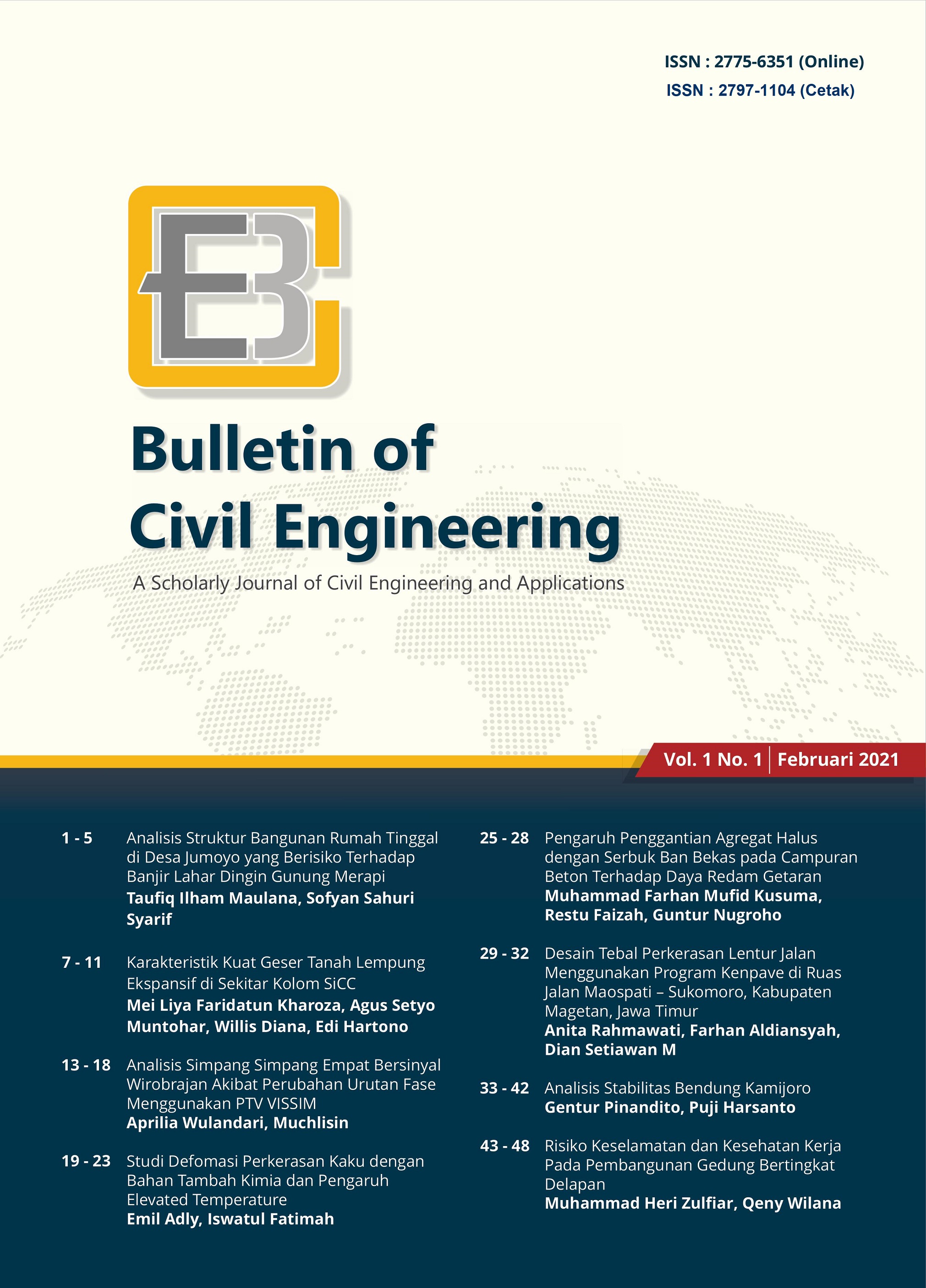Risiko Keselamatan dan Kesehatan Kerja (K3) Pada Pembangunan Gedung Bertingkat Delapan
DOI:
https://doi.org/10.18196/bce.v1i1.11065Keywords:
Keselamatan dan Kesehatan Kerja (K3), Manajemen K3, dan Tingkat risikoAbstract
Proyek gedung adalah salah satu penyumbang angka kecelakaan kerja terbesar di Indonesia, semakin besar proyek yang dibangun, maka semakin besar pula risiko kecelakaan kerja yang dapat terjadi. Oleh karena itu, perlu diperhatikan ketepatan dalam penerapan manajemen risiko yang diambil. Implementasi manajemen risiko dapat dituang dalam bentuk peraturan Keselamatan dan Kesehatan kerja (K3). Di Indonesia, masalah kecelakaan kerja masih terkesan diabaikan, hal ini terbukti dari angka kecelakaan kerja yang masih tinggi. Analisis risiko Keselamatan dan Kesehatan Kerja (K3) dilakukan sebagai tolak ukur seberapa aman atau seberapa besar risiko yang mengancam pekerja dalam melaksanakan aktivitas di lokasi proyek. Penelitian ini dilakukan dengan metode kuantitatif, yakni dengan memberikan penilaian/skor pada masing-masing variabel risiko kegiatan berdasarkan matriks risiko yang tersedia. Penilaian dilakukan dengan pengambilan data triplo, yakni dengan tiga narasumber yang kemudian diambil nilai rata-ratanya. Hasil dari analisis risiko Keselamatan dan Kesehatan Kerja (k3) yang telah dilakukan pada kegiatan struktural yakni penulangan, bekisting, dan pengecoran pada balok, pelat lantai, dan kolom di pembangunan Gedung Research and Inovation Center of Dasron Hamid Universitas Muhammadiyah Yogyakarta ini adalah kategori risiko sedang dengan nilai tingkat risiko rata-rata sebesar 9.
References
Awuy, T, Prastasis, P.A.K, dan Mangare, J.B. 2017. Faktor-faktor Penghambat Penerapan Sistem Manajemen K3 Pada Proyek Konstruksi di Kota Manado, Jurnal Sipil Statik Vol.5 No.4 Juni 2017 (187-194) ISSN: 2337-6732
Christina, W. Y., Djakfar, L., & Thoyib, A. 2012. Pengaruh Budaya Keselamatan dan Kesehatan Kerja (K3) terhadap kinerja proyek konstruksi. Rekayasa Sipil, 6(1), 83-95.
Ervianto, W. I. 2005. Manajemen Proyek Konstruksi Edisi Revisi. Yogyakarta: Andi Offset.
Ningsih, S. O. D., & Hati, S. W. 2019. Analisis Resiko Keselamatan Dan Kesehatan Kerja (K3) Dengan Menggunakan Metode Hazard and Operability Study (Hazop) Pada Bagian Hydrotest Manual Di Pt. Cladtek Bi Metal Manufacturing. Journal of Applied Business Administration, 3(1), 29-39.
Peraturan Menteri Tenaga Kerja RI Nomor 03/MEN/1998. Tata Cara Pelaporan dan Pemeriksaan Kecelakaan.
Soputan, G. E., Sompie, B. F., & Mandagi, R. J. 2014. Manajemen Risiko Kesehatan dan Keselamatan Kerja (K3) (Study Kasus Pada Pembangunan Gedung SMA Eben Haezar). Jurnal Ilmiah Media Engineering, 4(4).
Tjakra. 2011. Analisis Risiko Pada Proyek. Konstruksi Perumahan di Kota Manado Jurnal Ilmiah Media Engineering Vol. 1, No. 1, 29-37, ISSN 2087- 9334.
Tugeha, W. P. 2018. Manajemen Risiko Keselamatan dan Kesehatan Kerja Pada Proyek Konstruksi, Jurnal Sipil Statik Volume 6, No 11, 907- 916, ISSN 2337-6732.
Yuliandi, C. D., & Ahman, E. Penerapan Keselamatan dan Kesehatan Kerja (K3) di Lingkungan Kerja Balai Inseminasi Buatan (BIB) Lembang. Manajerial: Jurnal Manajemen dan Sistem Informasi, 18(2), 98-109.
Zulfiar, M. H., Jayady, A., Saputra, J., & Rukmono, N. 2018. Kerentanan Bangunan Rumah Cagar Budaya Terhadap Gempa di Yogyakarta. Jurnal Karkasa, 4(1), 5-12.
Downloads
Additional Files
Published
Issue
Section
License
Copyright
The Authors submitting a manuscript do so on the understanding that if accepted for publication, copyright of the article shall be assigned to Bulletin of Civil Engineering (BCE). Copyright encompasses rights to reproduce and deliver the article in all form and media, including reprints, photographs, microfilms, and any other similar reproductions, as well as translations.
Authors should sign Copyright Transfer Agreement when they have approved the final proofs sent by the journal prior the publication. BCE strives to ensure that no errors occur in the articles that have been published, both data errors and statements in the article.
BCE keep the rights to articles that have been published and hold the copyright limited solely for the publication. Authors are permitted to disseminate published article by sharing the link of BCE website. Authors are allowed to use their works for any purposes deemed necessary without written permission from BCE with an acknowledgement of initial publication in this journal.
License
All articles published in BCE are licensed under a Creative Commons Attribution-ShareAlike 4.0 International (CC BY-SA) license. You are free to:
- Share — copy and redistribute the material in any medium or format
- Adapt — remix, transform, and build upon the material for any purpose, even commercially.
The licensor cannot revoke these freedoms as long as you follow the license terms. Under the following terms:
- Attribution — You must give appropriate credit, provide a link to the license, and indicate if changes were made. You may do so in any reasonable manner, but not in any way that suggests the licensor endorses you or your use.
- ShareAlike — If you remix, transform, or build upon the material, you must distribute your contributions under the same license as the original.
- No additional restrictions — You may not apply legal terms or technological measures that legally restrict others from doing anything the license permits.



